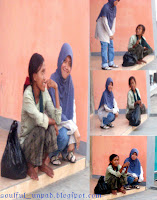Senin, 21 Desember 2009
Concept Violence
Generally clients with Violence Behavior forcibly taken to the Mental Hospital. Bound clients often appear inhuman growl and escort accompanied by a number of family members and even the police. Violence behaviors such as hitting a family member / someone else, damage household appliances and angry is the main reason most often raised by families. Handling by inadequate family, the family should receive health education about how to care for the client (management of violent behavior).
Definition
Violent behavior is a form of expression of anger is not appropriate, where the person doing the actions that may harm / injure themselves, other people can even damage the environment. Someone who experience this problem should be given a plan and appropriate action so that the pattern of expression of anger can be transformed into an acceptable form of appropriate behavior, which is a direct expression of anger to the source of anger with those who still appreciate the source of these outrages.
Psychological (mental), which experienced failure can lead to frustration which can arise aggressive or berserk. Childhood is an unpleasant feeling of being rejected, humiliated, abused or witness abuse.
Behavior reinforcement (reinforcement / support) received at the time of violence often observe violence at home or outside the house, all these aspects of individual menadopsi stimulate violent behavior.
Socio-cultural, and return closed culture of silence (passive aggressive) and social kontorol uncertain against perpetrators of violence will create as if violent behavior is accepted (permissive).
Bioneurologis, many of the opinion that the damage diotak neural systems are contributing to the occurrence of violent behavior.
2) Factor Cause
Condition clients such as physical weakness (physical illness), hopelessness, helplessness, self-confident
A noisy environment, solid, leading to criticism that the humiliation, loss of a loved one / employment and violence
Social interaction
3) Signs and Symptoms
Red face, sharp eyes, muscle tension, high tone, arguing. Often the client wishes to impose, take food, hitting if not happy. The interview focused on the causes of anger, feelings of anger, the signs of anger felt by someone.
4) Medical Treatment
Some drugs are often used to cope with aggressive behavior include:
o Anti-anxiety and sedative hypnotic example: Diazepam (Valium).
o Anti-depressants, for example Amitriptilin.
o Mood stabilizer, for example: Lithium, Carbamazepin.
o Antipsychotics, eg Chlorpromazine, Haloperidol and Stelazine.
o Other drugs: Naltrexon, Propanolol
5) Nursing Handling
There are three strategies of nursing actions on the client with violent behavior, according to the extent of violent acts committed by the client.
Action strategy consists of:
• Preventive strategy, consisting of self-awareness, client counseling and assertiveness training.
• Anticipation strategy, consisting of communication, environmental change, actions and behavior psikofarmakologi.
• Suppression strategy, consisting of crisis management, exile and binding.
Guidance
Clients need to be aware of how angry and how to communicate well is an effective way to prevent violent behavior. That anger is not a right or wrong, must be realized by the client. For that of counseling clients to prevent violent behavior includes:
Help clients identify anger.
Give a chance to upset.
Apply the expression of anger in real situations.
Identify alternative ways of expressing anger.
Risk of injury
Violent behavior
Concept of self-interference; chronic low self-esteem
Disruption of health care
Self-care deficit; bath and decorated
Ineffectiveness köping family; the inability of families caring for clients at home
Ineffective management of therapeutic programs
Nursing Diagnosis:
Risk of self harm behavior associated with violent behavior
Violent behavior associated with chronic low self-esteem
Disorders associated with health care self-care deficit and ornate baths
Ineffectiveness of the therapeutic program associated with the inability of families caring for a client
Intervention
Discuss physical activity that can be done Kien
Give praise for the bias of physical activity done client
Discuss the two ways the easiest physical done to prevent violent behavior, namely; dalan and inhale pukulkasur and pillows
Discuss how to take a deep breath with the client
Give an example to clients about how to take a deep breath
Ask the client to follow caontoh given 5 times
Give positive praise for the client's ability to demonstrate how to take a deep breath
Check the client's feelings after doing so
Instruct the client to perform the way they have learned when angry / upset
Do & teach clients to other afisik way as above at the next meeting
Discuss with the client about the frequency of exercises will be done by the client
Arrange a schedule of activities to train the way he had learned
The client evaluates the implementation of the exercise, how to prevent violent behavior that have been done by filling out the daily activity schedule (self-evaluation)
Validate the client's ability to do exercises
Give praise for success
Ask the client: "if the activities of violent behavior prevention can reduce feelings of anger?"
References:
Yosep, Iyus. 2009. Keperawatan Jiwa edisi Revisi. Bandung: Refika Aditama.
http://tensoulgroup.blogspot.com/





.jpg)



